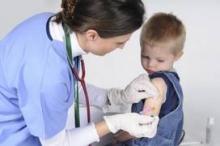Anaphylaxis in children following immunizations is extremely rare, with no events associated with infant and preschool schedule vaccinations and a delayed onset of symptoms in other children, according to a study published online Jan. 23 in Archives of Disease in Childhood.
Anaphylaxis may follow exposure to allergens from many sources, including vaccines made up of a mixture of compounds. Because anaphylaxis is rare, however, it is usually very difficult to pick this up as a potential side effect of a new treatment during clinical trials. Manufacturers have to rely on data collected after the product has come to market.
Dr. Michel Erlewyn-Lajeunesse of Children’s Allergy Clinic, University Hospital Southampton NHS Trust, and colleagues wanted to estimate the incidence and clinical presentation of anaphylaxes as an adverse event following immunization. Pediatricians in the United Kingdom and Ireland were asked to report all cases of suspected anaphylaxis in children younger than age 16 years following an immunization to the British Paediatric Surveillance Unit between September 30, 2008, and September 30, 2009 (Arch. Dis. Child 2012 [doi:10.1136/archdischild-2011-301163]). Reporting physicians also completed an online survey or patient questionnaires on the case presentation, diagnosis, management, and subsequent outcome.
During this time, physicians reported 15 cases of suspected anaphylaxis following vaccination, 7 of which the researchers confirmed. Six children required an injection of adrenaline, three received intravenous fluids, and all seven children fully recovered.
These included 2 cases among more than 16,000 single-component measles vaccines administered, for an incidence of 12 cases per 100,000. [No single-component measles vaccines are currently available in the United States.]
"A higher rate of anaphylaxis following single-component vaccines has been previously observed, although there is no obvious explanation for this," the researchers said. "Measures should be taken to record the use of non-routine vaccines so that the public may be protected." No cases of anaphylaxis occurred among the 5.5 million infants and preschool-age children who received normally scheduled vaccines, including measles, mumps, and rubella (MMR) and influenza. "This is extremely reassuring data for the general public and healthcare workers alike," they said.
There also were three cases of anaphylaxis among more than 2 million doses of human papillomavirus (HPV) vaccine, for an incidence of 1.4 cases per million doses.
Three children already carried injectable adrenaline to treat idiopathic anaphylaxis or multiple food allergies. "We suggest that children with idiopathic anaphylaxis are immunized in a center used to treating anaphylaxis and are observed for at least an hour following the procedure," Dr. Erlewyn-Lajeunesse and associates said.
The onset of symptoms was 15 minutes in three cases and 30 or more minutes in four cases (120 minutes in one case). The latter finding, observed in other studies, "is in keeping with an idiosyncratic non-immunoglobulin E-mediated reaction," they said. Although there is no standard observation time, the researchers said that an observation time of up to 60 minutes may be appropriate in children with a history of idiopathic anaphylaxis.
"Anaphylaxis remains a very rare adverse event following immunization," the researchers said. "There is a clear need for international surveillance using standardized methodologies and case definitions."
The U.S. Vaccine Adverse Event Reporting System (VAERS) recorded 452 reports of "anaphylactoid reactions" in over 1.9 billion doses of vaccine given over a 10-year period, for an estimated incidence of 0.2 cases per million doses.
This study was funded by an unrestricted educational grant from Sanofi Pasteur MSD. Dr. Erlewyn-Lajeunesse reported having received reimbursement from GlaxoSmithKline and Wyeth to attend scientific meetings. Coauthor Dr. Paul T. Heath is an investigator for clinical trials conducted on behalf of St. George’s, University of London, sponsored by vaccine manufacturers. Coauthor Dr. Adam Finn undertakes clinical trails and related research, consulting, lecturing, and chairing for all the major manufacturers and has received reimbursement of travel, accommodation, registration and living expenses relating to these activities. Dr. Pichichero said he had no relevant financial disclosures.


